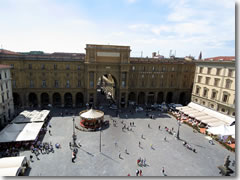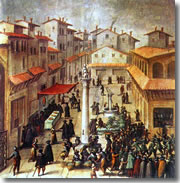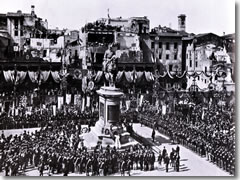
Piazza della Repubblica in Florence.As you wander Florence, you'll undoubtedly stumble across this large pedestrian square with a small carousel in the middle, its sides lined by shops and classy 19th century cafes.
This was originally the site of the forum (main square) for the ancient Roman settlement of Fiorentina.
By 1571 it had become the city's Jewish ghetto—meaning it was the one part of town where Jews were allowed to live.
It also housed loads of non-Jewish homes, churches, medieval craft guild headquarters, and the central marketplace—which in the 16th century became the Mercato Vecchio ("old market") after the Mercato Nuovo ("new market") was built a few blocks south.

How the area that is now Piazza della Repubblica looked in the early 1600s, including the Mercato Vecchio, painted by Flemish artist Jan Van der Straet ("Giovanni Stradano" in Italian).In a fit of enlightenment and equality during the Italian Unification movement in the 1860s—while Florence was, briefly, serving as the capital of the new Kingdom of Italy—the Jews were given leave to live where they wanted and, in an act that may seem a bit odd but was well-intentioned, the city started a 30-year project to raze the ghetto to the ground in an attempt to modernize and sanitize the city by making the modern piazza.
(I've always wondered how those 1860s Jews felt, being told they were now free to go anywhere... they just couldn't stay in the neighborhood where, for good or ill, their ancestors had been forced to live for centuries. For the record, Jewish life in Florence now centers around the 19th century Synagogue in the Santa Croce district.)
All this explains why such a large piazza in an otherwise Renaissance-obsessed city is today hemmed in by grandiose late-19th century buildings, their ground floors occupied either by shop-filled loggias or by Belle Époque cafes of high ceilings, chandeliers, tiny tables, and bow-tied waiters.

Piazza della Repubblica in 1890, midway through its makeover (looking in the same direction as the modern photo up above), with the west side still lined by medieval buildings. This photo was taken at the ceremony to inaugurate the pictured statue of Vittorio Emanuele II in the presence of the king himself. Florentines never liked the statue, which has since been banished to Cascine park.(Caffè Gilli is where the dreamers of the Risorgimento unification movement once met; Caffè Giubbe Rosse, with its namesake red-tuxedoed waiters, is where the Futurists and literary types once met. Both are pretty, but way overpriced,)
The only thing the centuries have left (sort of) intact from the original square is the Column of Abundance stuck in the northeast corner.
(For the record, this column, topped by a gray statue of "Abundance," is actually a 1956 replica of the much-deteriorated 1721 version, which itself replaced the lost 1431 original by Donatello.)
Even though the column is stuck in the corner of the piazza, it's actually not off-center. The piazza is.
The column marks the exact center of the original Roman city of Fiorentina, the spot where the original Cardo Maximus (the "Main Street" of any Roman city, running north-south; today it's called Via Roma/Via Calimala) crossed the original Decamanus Maximus (the main east-west street; today's Via del Corso/Via degli Speziali/Via degli Strozzi).
Piazza della Repubblica, where Via Roma/Via Calimala meets Via degli Speziali/Via Strozzi
24/7
Free
Bus: C2
Hop-on/hop-off: Santa Croce (A), Corso Tortini (C)
Planning your day: Other than hanging out at a cafe, visiting the excellent Edison mega-bookstore under the arcades on the west side, or popping into Florence's main post office in the square's southwest corner, there's no overt reason to come here, though you will likely pass through at some point.
Take a guided tour of Piazza della Repubblica with one of our partners:
Share this page
Search ReidsItaly.com
Piazza della Repubblica, where Via Roma/Via Calimala meets Via degli Speziali/Via Strozzi
24/7
Free
Bus: C2
Hop-on/hop-off: Santa Croce (A), Corso Tortini (C)